As you delve into the various publications related to climate change, you find it runs the gamut from impenetrable to porous. I personally find much of design writing on the subject a bit toothless, and as far as scientific writings, the NCA4 pretty readable and compelling, whereas the IPCC reports require a bit of a slog to wring out the specifics. On the other hand, there’s more mainstream writings, of which Mark Maslin’s ‘Climate Change: A Very Short Introduction‘ was a good take, and more focused books like ‘Planning for Climate Change‘ compile more academic writings from multiple sources and collect them, which offers a broader and more applied view.
The hot take of the moment is the much discussed ‘The Uninhabitable Earth‘ by David Wallace-Wells, of which I’m reading and will report on at some point, which build on legacies of books like ‘Field Notes from a Catastrophe‘ by Elizabeth Kolbert, or ‘This Changes Everything‘ by Naomi Klein, more journalistic and, frankly, more readable, format, while still being dense with information. In sum, the message takes many forms, and each offers a different path to fully understanding climate change science, the myriad impacts to the environment and society, and the range of possible solutions.
Which brings me to Drawdown, which is a bit of a hybrid — both a best-selling book and a complementary website aimed at strategies to reverse global warming. Edited by Paul Hawken, it includes over 80 strategies, along with cruching the numbers on GHG emissions reductions, and cost-benefits in order to show how much mitigation impact there could be if these were adopted and implemented over the next 30 years.
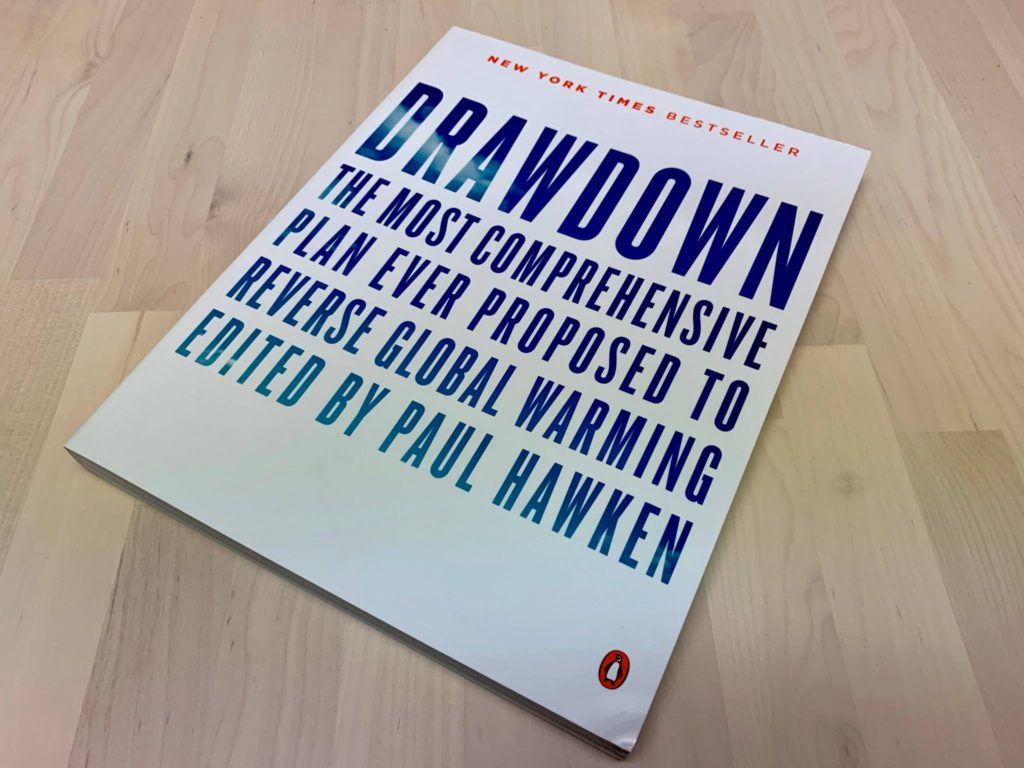
I gave a short talk recently at the Urban Ecology Research Consortium here in Portland, and have another slightly longer one upcoming on the same topic at Grey to Green Conference in Toronto in early April which uses Drawdown as the framework for how landscape architecture can engage in climate design. As a bit of a prod to myself to continue to expand my thinking from the shorter presentation to the longer one, and a way to elaborate on concepts for future presentations, I’m going to do a daily post on an aspect of Drawdown related to Landscape Architecture and how it can inform the profession as we search for solutions to how we related to climate change. If you’ve read the book or spent any time on the website, and have been inspired by parts or not, let me know.
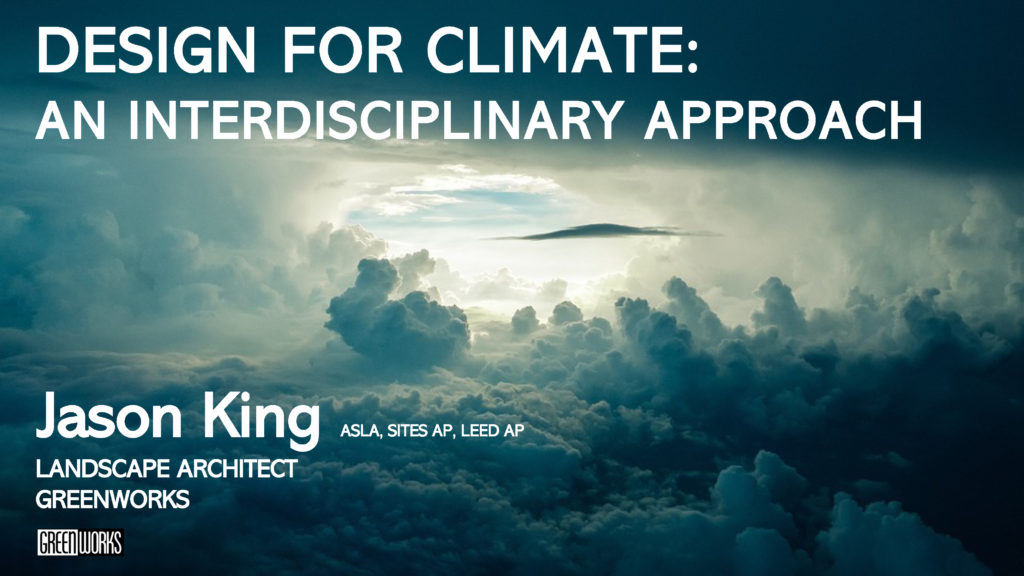
DAILY DRAWDOWN 1: LESSONS FOR LANDSCAPE ARCHITECTS
For a short intro to Drawdown, it’s important to understand the term, specifically as laid out in the books intro by Hawken: “In atmospheric terms drawdown is that point in time at which greenhouse gases peak and begin to decline on a year-to-year basis.” (x) In that context, the book has the goal of looking at solutions that will be compatible with this lowering of greenhouse gas emissions (GHG). While new innovations will ultimately help us get there, he mentions the fact that we’ve already got all of the tools, stating that during the process we “found a plan, a blueprint that already exists in the world in the form of humanity’s collective wisdom, made manifest in applied, hands-on practices and technologies that are commonly available, economically viable, and scientifically valid.” (x) Further, Hawken adds that the strategies with maximum impact are those solutions:
“…that lead to regenerative economic outcomes that create security, produce jobs, improve health, save money, facilitate mobility, eliminate hunger, prevent pollution, restore soil, clean rivers, and more.”
The strategies are grouped into specific sectors, including Materials, Energy, Food, Land Use, Women & Girls, Transport, and Building & Cities. Each of these includes summary info, and a ranking based on the amount of CO2 reduction. The same information is available via the website, along with other metrics
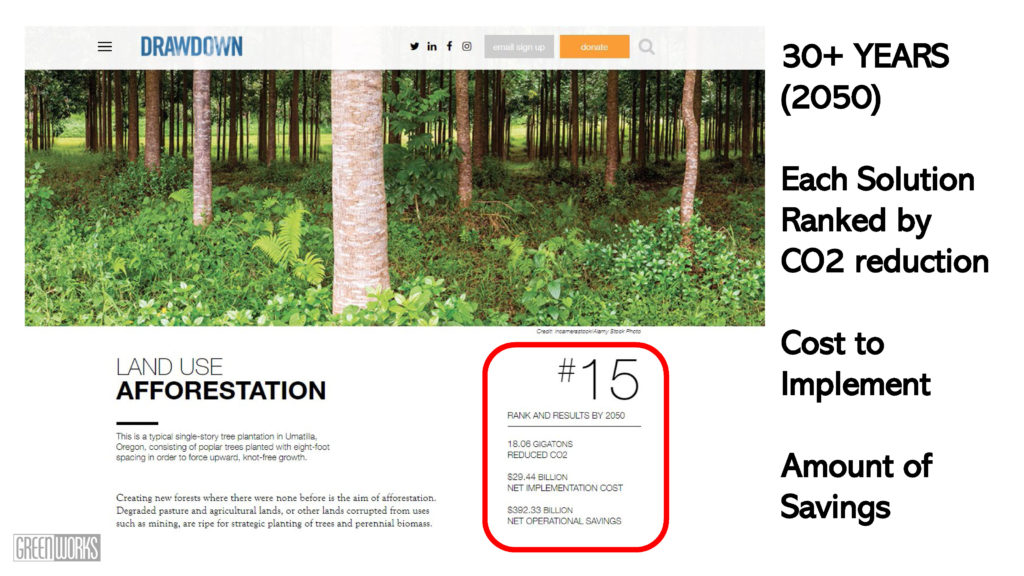
And there’s a lot of strategies, along with some coverage of what are known as ‘Coming Attractions’, which highlight new technologies or alternative solutions. While it isn’t as straightforward as ‘here’s all the answers’ go do it, Drawdown does provide a valuable, action-oriented resource and gives an informed base of evidence to prioritization of strategies, regardless of what discipline you work in.
That said, as a landscape architect, when I read it the first time, I was sort of non-plussed by a perceived lack of initial relevance to our professional scope. While Green Roofs were one of the solutions that is clearly in our purview, many of those listed tended to be about global scale interventions, energy sector opportunities, or other social and agricultural systems that, even if related in landscape, were not really in alignment with what could be influenced by landscape architecture practices. This is indicative of the fact that climate change and combating global warming is a multifaceted and interdisplinary project, it was somewhat disheartening to not see our potential reflected in these solutions.
As a further challenge, I wanted to ‘read between the lines’ and discover if there was more than initially meets the eyes. After going through the book, I actively noted both landscape architecture relevance and the strength of those connections, and sorted the 80 categories using those metrics, and came to a different conclusion: that Drawdown does provide a good starting point for alignment with landscape architecture.
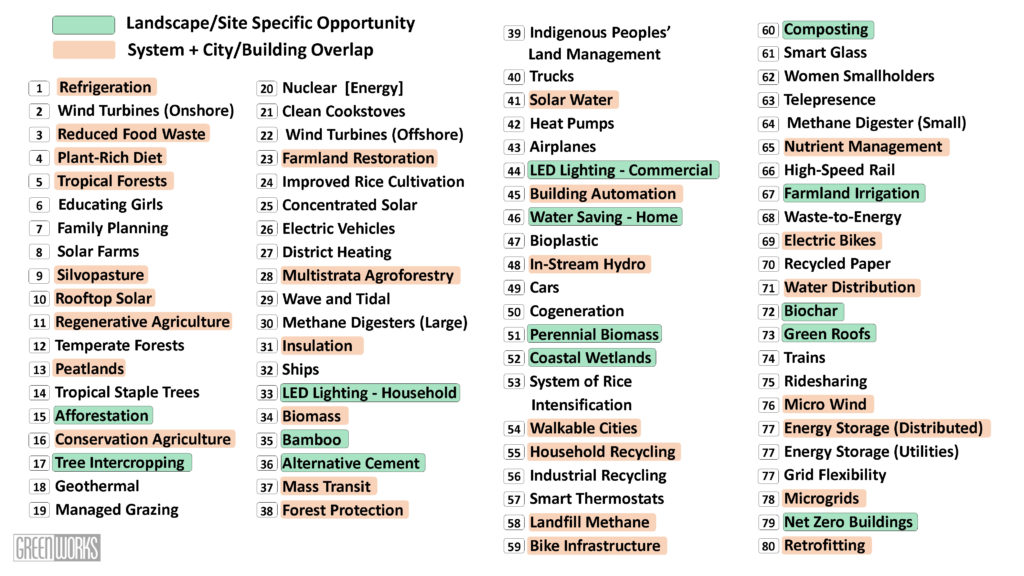
As you can see from the appended list above, my first task was to look at all of the strategies, and determine whether it was directly related to landscapes and sites (those highlighted in Green above), either as common project typologies (i.e. Green Roofs, Coastal Wetlands) or using common materials (i.e. Composting, Irrigation, LEDs, Alternative Cement). Some additional strategies were included because they overlapped with landscape systems in meaningful ways, and while meant for larger, agricultural systems, have some relevance and interest in landscape architects integrating these into our approaches – and maybe challenging notions of what landscape architecture can be. These include, for instance Afforestation, which could be done in urban contexts, Tree Intercropping, perhaps in the concept of urban Food Forests, and Perennial Biomass, which could use landscape waste materials as an energy source.
A secondary overlay was to identify related strategies that included systems influenced by and influencing landscapes, along with those related to related endeavors of city planning and architecture (noted in Orange above). This included potential strategies such as Regenerative Agriculture, or In-Stream Hydro that would be fully applicable to landscape architecture projects in some scales and contexts, Energy Storage and Solar, which could be used on any project to power sites. Building specifics as well include Insulation, Building Automation, and Retrofitting, all of which could expand to include more landscape- and site-specifics.
The urban lens focused on ‘smart growth’ strategies that are fully compatible and relevant to our designs, and a larger scale, like Mass Transit, Bike Infrastructure, and Walkable Cities. A further materials lens is pointed at extraction economies and how we as a profession are able to influence these in positive ways. Some example so this include protection of enhancement of Tropical Forests through smart specification or reduction of use of tropical hardwoods like Ipe in our designs, or protection of Peatlands by not specifying peat as a landscape amendment.
As you see, there are a lot of broader applications that inform landscape architecture. The result of this analysis was to ‘reorder’ the strategies based on landscape architecture, so by doing so, to extract a more focused reading of the rankings – seen in a summary below. When you add up the full ‘potential’ for these strategies per Drawdown’s metrics, it is equivalent to over 82 gigatons of CO2 potentially reduced over the next 30 years, which could have a major impact on turning the tide of global warming.
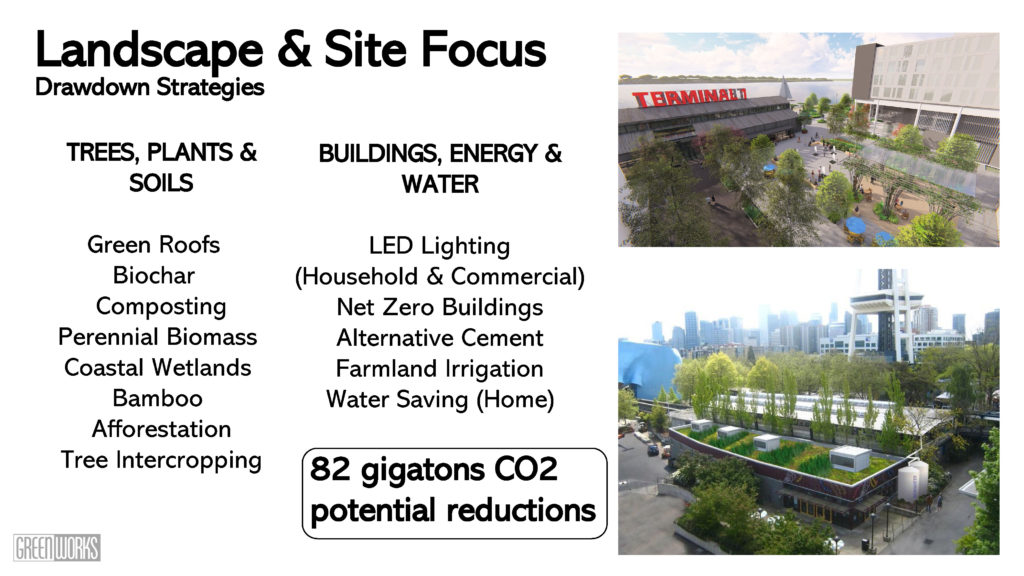
Obviously this amount of GHG reduction isn’t coming from just landscape architecture projects, as many of these are larger scale and global in reach, but its a hint at relevance and perhaps inspire some more positive counter-narrative to what is often dismissal of our role and potential in being part of the solution. We can argue all day about the overall scale of our work and how much impact we can possibly have- but it really isn’t about the size of our contribution as it is about the ability to leverage all aspects of our work towards being actively part of the solution. Thus the point here is to generate ideas and maximize how much we (landscape architects) can contribute to solving the problem of climate change, and adopt the mantra of Drawdown, to “reverse global warming”. Or perhaps in a more broad sense, to adopt Hawken’s thinking mentioned later in the book:
“Climate solutions depend on community, collaboration and cooperation” (217)
More to come on these all specifically, but that’s the gist of this introductory take – and stay tuned for a specific take on this daily for the next couple of weeks.
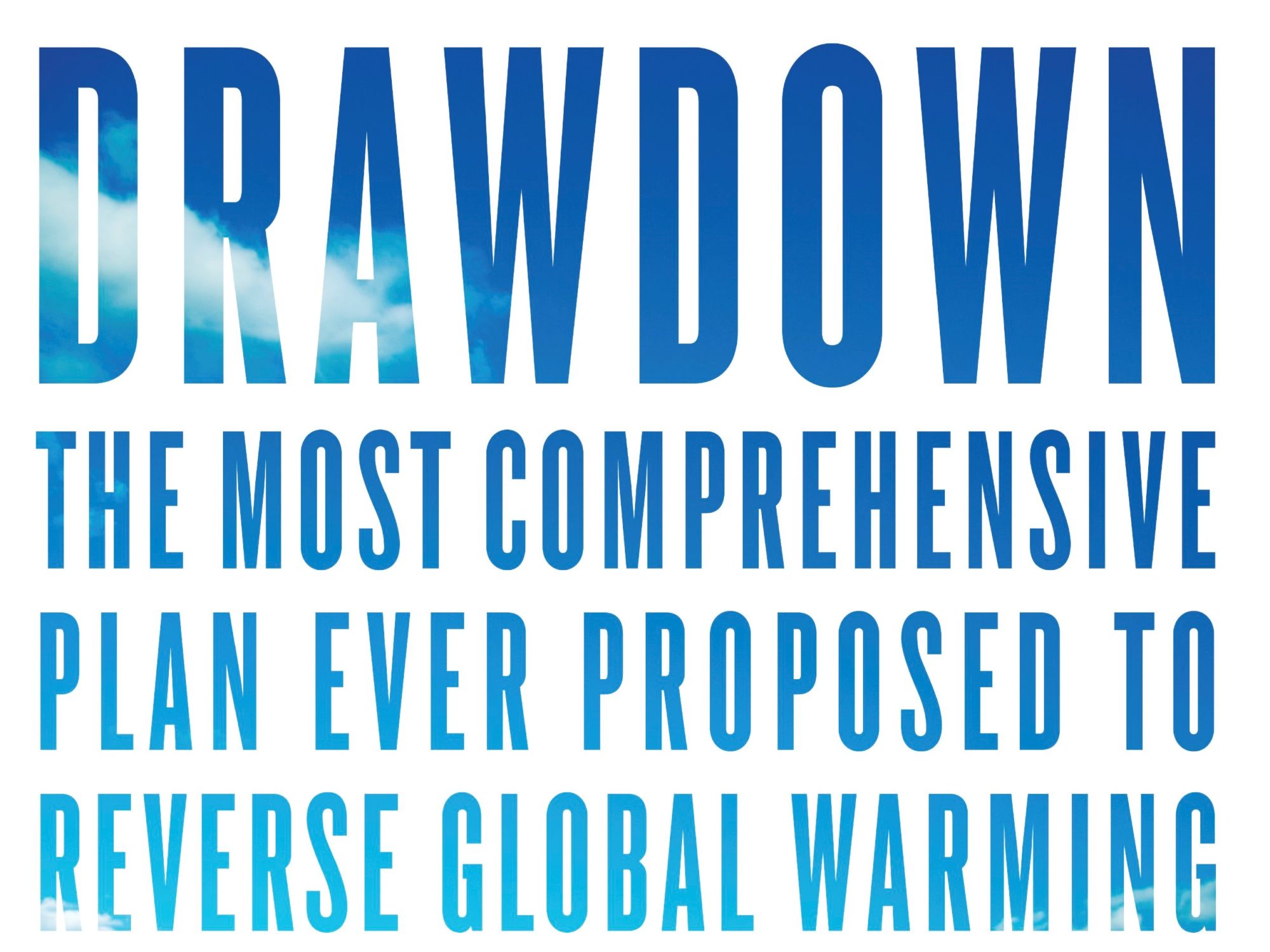
This is a great series of posts!